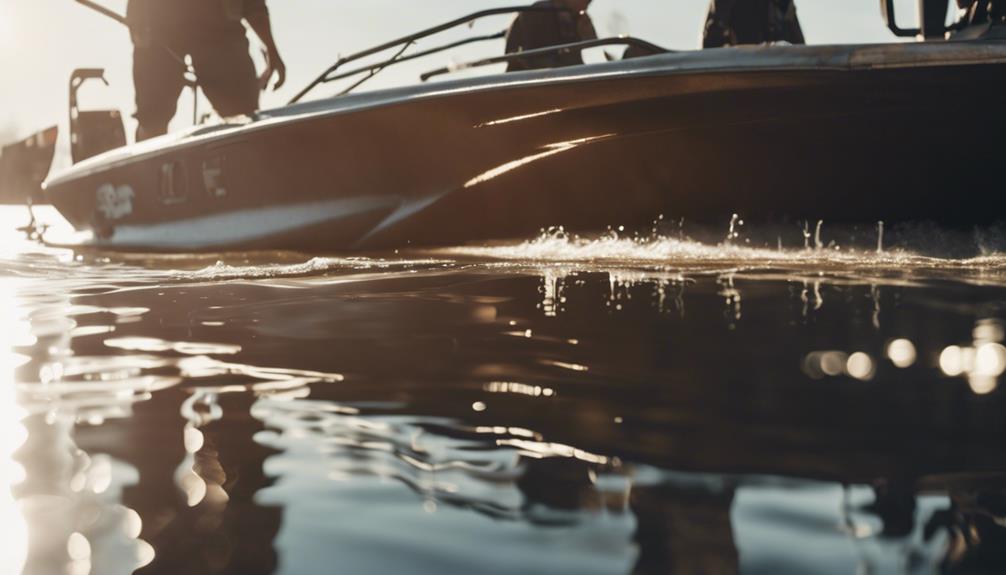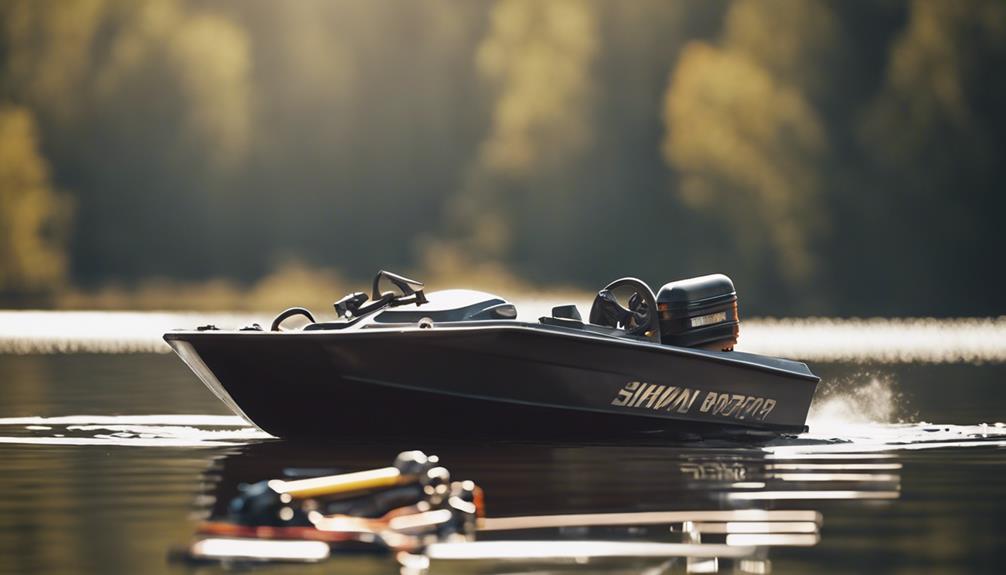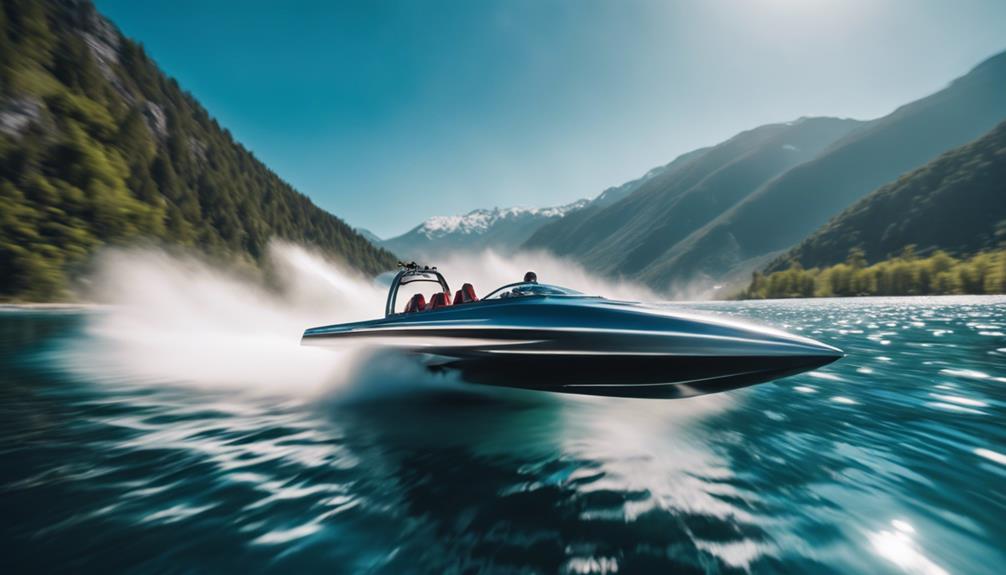If you're considering buying a jet boat, think about your primary usage, local water conditions, and passenger capacity. Jet boats offer impressive acceleration and maneuverability, but they can be pricier to maintain and operate. It's crucial to inspect the boat's condition, check maintenance records, and verify safety features are in place. Budget for both initial costs and ongoing expenses like fuel and insurance. If you take your time to evaluate models and test drive options, you'll make a smarter investment. There's more to explore about what makes a perfect jet boat for your needs, so keep this in mind!
Key Takeaways
- Assess your primary usage needs, such as wake surfing or leisure cruising, to determine if a jet boat is suitable.
- Evaluate local water conditions and potential obstacles to ensure the boat's performance meets your requirements.
- Consider maintenance history and frequency to ensure reliability and optimal performance over time.
- Review safety features, such as life jackets and navigation lights, to ensure compliance with regulations and safe operation.
Assessing Your Needs
When evaluating your needs for a jet boat, consider how you'll primarily use it, as this will greatly influence your choice. If you're looking to wake surf or wakeboard, you'll want a model that excels in shallow, calm waters. Jet boats are known for their rapid acceleration and excellent maneuverability, making them perfect for these activities.
Next, think about local water conditions. Jet boats perform exceptionally well in areas with submerged obstacles like pilings and dead trees, but they can struggle in rough waters or heavy chop. This consideration is vital to guarantee you enjoy your time on the water safely.
Also, assess how many passengers you typically have. Some models, like the Sea-Doo Challenger, offer higher seating capacities, while sportier options like the Speedster cater to smaller groups.
Evaluating Boat Condition

Evaluating the condition of a jet boat is vital to confirm you're making a wise investment and avoiding costly repairs down the line. Start by inspecting the hull for any signs of delamination, blistering, or faded gel coat, which might indicate sun damage. Next, check the impeller for damage and verify it has minimal play in all directions; excessive movement can lead to performance issues.
Additionally, focus on the interior. Look for upholstery wear and double-check that all components, including lights and switches, are functional to prevent future repair costs. It's also important to assess the structural integrity of the stringers and subfloor, as compromised components can pose safety risks. Finally, don't overlook the trailer; verify that brakes and lights work properly, as a neglected trailer could affect transport safety.
Here's a quick checklist to help you evaluate your potential jet boat:
| Component | Things to Check |
|---|---|
| Hull | Delamination, blistering, gel coat damage |
| Impeller | Damage, play in all directions |
| Interior | Upholstery wear, functionality of parts |
| Trailer | Brake and light functionality |
Understanding Performance Features

When choosing a jet boat, you'll want to pay close attention to its acceleration and responsiveness.
The hull design plays an essential role in how fast and maneuverable your boat will be on the water.
Understanding these performance features will help you select a vessel that meets your needs for both speed and handling.
Acceleration and Responsiveness
Jet boats deliver impressive acceleration and responsiveness, thanks to their innovative jet drive system that excels in shallow waters and tight maneuvers. The jet drives allow for rapid planing, enabling you to experience quick launches and agile handling. Unlike traditional propeller boats, jet boats utilize an impeller design that provides immediate thrust, making them stand out in both speed and agility.
Here's a quick comparison of performance features:
| Feature | Jet Boats | Traditional Boats |
|---|---|---|
| Acceleration | Rapid and powerful | Slower and gradual |
| Responsiveness | High maneuverability | Limited agility |
| Thrust Efficiency | Maintains thrust | Susceptible to cavitation |
| Handling in Shallow | Excellent | Complicated |
| Weight Distribution | Lighter hulls favored | Heavier hulls |
The jet propulsion system minimizes cavitation, ensuring that you maintain thrust efficiency even in challenging conditions. Overall, if you prioritize acceleration and responsiveness, a jet boat could be the perfect choice for your aquatic adventures, providing a thrilling experience in various environments.
Hull Design Impact
Understanding how hull design impacts performance is fundamental for maximizing your jet boat's capabilities on the water. The hull design plays an important role in how your boat handles different conditions.
For instance, delta pads can greatly improve your jet boat's top speed by reducing drag and enhancing planing efficiency. If you often navigate through choppy waters, a deeper-V hull design will offer better stability and handling, making it more suitable for those rough conditions. Conversely, a flatter hull excels in shallow water, providing agility and quick maneuverability.
If speed and fuel efficiency are priorities, consider jet boats with stepped hulls. These designs minimize wetted surface area, leading to faster acceleration. However, keep in mind that weight distribution within the hull can affect balance and responsiveness, impacting your boat's performance during high-speed turns.
Lastly, understanding how your hull shape interacts with water flow is essential. Certain designs can cause cavitation, which can hinder acceleration and overall performance at high speeds. By choosing the right hull design, you'll guarantee your jet boat performs at its best in the conditions you encounter most.
Maintenance and Care History

When you're considering a jet boat, examining its maintenance and care history is essential.
You'll want to ask about oil change frequency and look for signs of good upkeep, like a clean bilge area.
Checking repair records and evaluating the condition of components will help you gauge how well the previous owner treated the boat.
Maintenance Frequency Importance
Regular maintenance is essential for ensuring your boat remains reliable and performs at its best over time. You should prioritize a well-documented maintenance history when considering a jet boat. A consistent routine of oil changes is vital for maintaining engine health; skipping these can lead to significant performance issues and expensive repairs down the line.
Examine the boat's service records to understand how frequently inspections and repairs were conducted. Regular inspections can prevent future mechanical failures, saving you time and money. A clean bilge often indicates good ownership, while dirt and rust could signal a history of neglect.
Additionally, pay attention to the condition of the gel coat. Fading or damage might suggest prolonged exposure to the elements without proper care. Boats with a solid maintenance history are generally more dependable, giving you peace of mind on the water.
Condition Assessment Techniques
Evaluating a jet boat's condition involves a detailed inspection of both its exterior and interior to uncover signs of wear, damage, and the level of care it received from previous owners.
Start with the hull; check for delamination, blistering, or fading gel coat, as these can indicate neglect or poor maintenance history. Don't forget to inspect the interior, focusing on upholstery damage, which can reflect overall care.
Next, verify the functionality of all components. Test lights, switches, and ascertain safety equipment like life jackets and fire extinguishers are present and compliant with safety standards. This inspection helps gauge the boat's readiness for use and reveals the owner's commitment to maintenance.
Review the boat's maintenance history too. Ask about oil change frequency and inspect the bilge; a clean bilge suggests responsible ownership.
Finally, perform a compression test on the engine. Values above 110 PSI indicate a healthy engine, giving you insight into its operational condition and future maintenance needs.
Repair History Verification
Requesting the maintenance records from the seller gives you a clearer picture of the jet boat's care history and any potential red flags. Focus on details like oil change frequency and any repairs made; these can help you identify patterns of care or neglect.
A thorough inspection of the bilge is essential, too. A clean bilge often indicates attentive ownership, while dirt and rust may signal poor maintenance practices.
Additionally, inquire about any past accidents or damage. Understanding the boat's repair history can reveal how those incidents might impact performance and safety.
You should also assess the condition of the gel coat, as its state reflects the overall care of the boat. Fading or damage may indicate exposure to harsh conditions without proper maintenance.
Safety Features to Consider

When buying a jet boat, it's essential to prioritize important safety features to guarantee a secure and enjoyable experience on the water. You'll want to make sure your boat is equipped with the necessary gear to handle emergencies effectively. Here are some key safety features to take into account:
- Life jackets: Make sure there's a sufficient number and they meet safety standards.
- Navigation lights: Verify they're operational for safe night travel and visibility to other vessels.
- Functional bilge pump: This is critical for removing water and preventing capsizing.
- Sound signaling device: This legal requirement alerts nearby boats of your presence.
Additionally, think about other safety equipment like flares, depth finders, and GPS systems to enhance your navigation capabilities.
Don't forget about weather protection accessories, like a bimini top, which can shield you from the sun and sudden weather changes.
Budgeting for Ownership Costs

Making certain your jet boat is safe is just the beginning; you'll also need to carefully plan for the ongoing costs of ownership to keep your boating experience enjoyable. Start by setting a realistic budget for your purchase. For a used jet boat, expect to spend between $4,000 and $5,000, especially on models from 1995 to 2002 for better pricing options.
Next, consider the ongoing maintenance costs. Older models often require more frequent repairs, so be prepared for these expenses, which can greatly impact your overall budget.
Don't forget about insurance; the cost can vary based on the boat type and how you plan to use it. Research different insurance options to find the best fit for your needs.
Additionally, factor in fuel costs, as jet boats typically have lower fuel efficiency compared to outboard engines. This will affect your long-term operating expenses.
Exploring Alternative Options

Often, exploring alternative options like runabouts, center consoles, and pontoon boats can lead you to a more suitable choice for your specific boating needs. While a jet boat might seem appealing, you should consider the unique benefits these alternatives offer, tailored to different activities and water conditions.
Runabouts are versatile for cruising and light watersports.
Center consoles provide easy upkeep and multiple power options, ideal for fishing and longer trips.
Bow riders offer more seating for social outings but may require more maintenance.
Pontoon boats excel in relaxation and social gatherings on calm waters, perfect for family outings.
Inflatable boats are portable and easy to store, great for smaller craft needs.
Tips for a Successful Purchase

Exploring alternative options can help clarify what you truly want, making it easier to navigate the tips for a successful jet boat purchase. Here are some essential steps to reflect upon:
- Inspect Thoroughly: Check the hull for damage, and verify the engine has good compression (ideally over 110 PSI). Look at all components to guarantee functionality.
- Review History: Look at the maintenance records. Regular oil changes and repairs indicate reliability.
- Research Models: Compare similar jet boats and their market values. Aim to negotiate at least $1,000 off based on your findings.
- Test Drive: Always take the boat for a spin. Evaluate handling, acceleration, and comfort while reflecting on local water conditions.
- Engage with Communities: Join online forums and local groups. They can offer valuable insights about specific models and maintenance tips.
Here's a quick reference table to help you keep track:
| Tip | Details |
|---|---|
| Inspect Condition | Check hull, engine, and components |
| Review Maintenance | Look for service records and repairs |
| Test Drive | Evaluate performance in local water |
Frequently Asked Questions
What Are the Downsides of Jet Boats?
Jet boats have downsides like higher fuel costs, excessive noise, and challenging slow-speed handling. They may underperform in rough waters, and without a propeller, they're prone to debris damage, limiting your options in shallow areas.
Which Is Better, a Jet Boat or a Prop?
Imagine gliding effortlessly through narrow rivers, your jet boat dancing around obstacles. If you crave agility in shallow waters, jet boats soar. For cruising and towing, propeller boats deliver efficiency and stability that can't be ignored.
Do Yamaha Jet Boats Hold Their Value?
Yes, Yamaha jet boats hold their value well. They typically retain 60-70% of their original price after five years, thanks to their reliability, performance, and popular features, making them a smart investment in the long run.
How Many Hours Are a Lot for a Jet Boat?
Like a worn-out pair of shoes, jet boats with over 300-400 hours show significant wear. You'll want to take into account usage type, maintenance history, and overall condition, as they greatly affect performance and reliability.
What are the main factors to consider when buying a jet boat?
When purchasing a jet boat, the ultimate jet boat buyer’s guide emphasizes considering factors like engine power, hull design, seating capacity, and maneuverability. It’s crucial to also assess the reliability of the brand, the maintenance costs, and the intended usage of the boat. Testing drive performance is key.
Conclusion
In the end, buying a jet boat can be an exhilarating adventure, but it's essential to weigh your options carefully.
Imagine cruising across the water, the wind in your hair, and the sun on your face—doesn't that sound enticing?
By evaluating your needs, understanding the performance features, and budgeting wisely, you can make a smart purchase that'll bring joy for years to come.
So, are you ready to make waves? Your perfect jet boat awaits!










